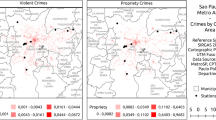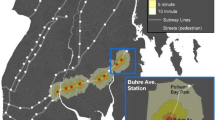Abstract
Objectives
We use the temporary closings of subway stations in Philadelphia to examine the effects of public transit on crime in the nearby communities.
Methods
The Southeastern Pennsylvania Transportation Authority (SEPTA), a regional public transportation authority in Philadelphia, has experienced two labor strikes occurring in 2009 and 2016. During these two strikes, public transit was disrupted for nearly 1 week. We used the closings of 47 subway stations during strikes to evaluate the place-based effect of public transit on crime. We also examined whether these effects varied with the ridership level in each station.
Results
Total crime decreased by 38% within 100 m of the stations when subway stations were closed due to the strike and by 10% within 500 m. The primary drivers of the decrease were violent crimes, including assault and robbery. However, there is no obvious relationship between the closings of stations and the change in property crimes and mischief. In addition, crimes in stations with higher ridership declined less than those in stations with medium ridership when strikes occurred.
Conclusions
Public transit in Philadelphia appears to be associated with elevated violent crime in the surrounding community. Areas around subway stations may require greater security to control crime during its operational hours. Passengers may serve as guardians to deter some crimes when the public transit is operational.





Similar content being viewed by others
Notes
The “assaults” category includes both aggravated assault and other assaults. The “robbery” category includes robberies with or without firearms. The “theft/larceny” category include motor vehicle thefts, thefts from vehicle, and other thefts. The “mischief” category includes receiving stolen property, disorderly conduct, gambling violations, liquor law violations, prostitution/commercialized vice, public drunkenness, vagrancy/loitering, vandalism/criminal mischief, and driving under the influence. The “Total” category includes all of the above offenses as well as other rare crime types such as homicide, rape, and arson.
We labeled 11 stations with the greatest number of passenger boards as stations of high level of ridership. All these stations have over 7000 boards on an average weekday. And we labeled 10 stations with the smallest number of passenger boards as stations of low level of ridership. All these stations have fewer than 3000 boards on an average weekday.
References
Billings, S., Leland, S., & Swindell, D. (2011). The effects of the announcement and opening of light rail transit stations on neighborhood crime. Journal of Urban Affairs, 33(5), 549–566.
Block, R., & Block, C. R. (2000). The Bronx and Chicago: street robbery in the environs of rapid transit. Analyzing Crime Patterns: Frontiers of Practice, 137–152.
Braga, A. A., Papachristos, A. V., & Hureau, D. M. (2010). The concentration and stability of gun violence at micro places in Boston, 1980–2008. Journal of Quantitative Criminology, 26(1), 33–53.
Brantingham, P. L., & Brantingham, P. J. (1993). Nodes, paths and edges: considerations on the complexity of crime and the physical environment. Journal of Environmental Psychology, 13, 3–28.
Cheape, C. W. (1980). Moving the masses: urban public transit in New York, Boston, and Philadelphia, 1880–1912. Cambridge: Harvard Press.
Cohen, L. E., & Felson, M. (1979). Social change and crime rate trends: a routine activity approach. American Sociological Review, 44(4), 588–608.
DeAngelo, G., Gittings, K., Grossman, D. S., & Khalil, U. (2019). Urban transport and crime: evidence from unanticipated mass transit strikes. Economic Inquiry, 35(1), 1–20.
Draca, M., Machin, S., & Witt, R. (2011). Panic on the streets of London: police, crime, and the July 2005 terror attacks. The American Economic Review, 101(5), 2157–2181.
Faraji, S.-L., Ridgeway, G., & Wu, Y. (2018). Effect of emergency winter homeless shelters on property. Journal of Experimental Criminology, 14, 129–140.
Ihlanfeldt, K. R. (2003). Rail transit and neighborhood crime: the case of Atlanta, Georgia. Southern Economic Journal, 70(2), 273–294.
Jackson, C. K., & Owens, E. G. (2011). One for the road: public transportation, alcohol consumption, and intoxicated driving. Journal of Public Economics, 106–121.
Kelling, G. L., & Wilson, J. Q. (1982). Broken windows: The police and neighborhood safety. The Atlantic March, 1-10.
Klick, J., & Tabarrok, A. (2005). Using terror alert levels to estimate the effect of police on crime. The Journal of Law & Economics, 48(1), 267–279.
Liggett, R., Loukaitou-Sideris, A., & Iseki, H. (2003). Journeys to crime: assessing the effects of a light rail line on crime in the. Journal of Public Transportation, 6(3), 85–115.
Lin, J., Bergen, J. M., & O'Reilly, D. (2009). A look back: For commuters, Day One of 2009 SEPTA strike was a day that went from bad to worse. Retrieved October 29, 2019, from The Philadelphia Inquirer: https://www.inquirer.com/philly/news/20091104_For_commuters__a_day_that_went_from_bad_to_worse.html.
Loukaitou-sideris, A. (1999). Hot spots of bus stop crime: the importance of environmental attributes. Journal of the American Planning Association, 65(4), 395–411.
Loukaitou-Sideris, A., Liggett, R. I., & Thurlow, W. (2001). Measuring the effects of built environment on bus stop crime. Environment and planning B: planning and design. Environment and Planning B: Planning and Design, 28, 255–280.
Moyer, R. A., & Ridgeway, G. (2018). The effect of outpatient methadone maintenance treatment facilities on place-based crime. Journal of Experimental Criminology, 1(1), 1–19.
Philadelphia Police Department. (2017). OpenDataPhilly crime incidents. Retrieved from https://data.phila.gov/visualizations/crime-incidents.
Phillips, D. C., & Sandler, D. (2015). Does public transit spread crime? Evidence from temporary rail station closures. Regional Science and Urban Economics, 52, 13–26.
Poister, T. H. (1996). Transit-related crime in suburban areas. Journal of Urban Affairs, 18(1), 63–75.
Ridgeway, G., & MacDonald, J. M. (2017). Effect of rail transit on crime: a study of Los Angeles from 1988 to 2014. Journal of Quantitative Criminology, 33(2), 277–291.
Sasko, C. (2016). SEPTA Strike, Day 3: Negotiations and Commuting Chaos Continue. Retrieved October 29, 2019, from Philadelphia: https://www.phillymag.com/news/2016/11/03/septa-strike-day-3/.
SEPTA. (2009). SEPTA Announces Service Interruption Guide. Retrieved October 29, 2019, from http://www.septa.org/media/releases/2009/10-28.html.
SEPTA. (2014). Broad Street Subway census. Philadelphia: Southeastern Pennsylvania Transportation Authority.
SEPTA. (2016a). 2016 Service Interruption Information. Retrieved October 29, 2019, from SEPTA: http://www.septa.org/service/interruption/2016-guide.html.
SEPTA. (2016b). Market Frankford Line ridership census. Philadelphia: Southeastern Pennsylvania Transportation Authority.
SEPTA. (2016c). SEPTA Announces Service Interruption Guide. Retrieved October 29, 2019, from SEPTA: http://www.septa.org/media/releases/2016/10-26-16.html.
SEPTA. (2016d). SEPTA, TWU Local 234 Announce Tentative Five-Year Contract. Retrieved from http://septa.org/media/releases/2016/11-07-16.html.
Smith, M. J., & Clarke, R. V. (2000). Crime and public transport. Crime and Justice, 27, 169–233.
Taylor, R. B. (1997). Social order and disorder of street blocks and neighborhoods: ecology, microecology, and the systemic model of social disorganization. Journal of Research in Crime and Delinquency, 34(1), 113–155.
Wachs, M. (1993). Learning from Los Angeles: transport, urban form, and air quality. Transportation, 20(4), 329–354.
Wakeford, R. (2015). Association and causation in epidemiology – half a century since the publication of Bradford Hill’s interpretational guidance. Journal of the Royal Society of Medicine, 108(1), 4–6.
Wang, R., & De Gruttola, V. (2017). The use of permutation tests for the analysis of parallel and stepped-wedge cluster-randomized trials. Statistics in Medicine, 36(18), 2831–2843.
Weisburd, D. (2015). The law of crime concentration and the criminology of place. Criminology, 53(2), 133–157.
Acknowledgments
The authors thank Professor John M. MacDonald (University of Pennsylvania), Professor Charles Loeffler (University of Pennsylvania), and the JEC reviewers for their helpful comments about the manuscript.
Author information
Authors and Affiliations
Corresponding author
Additional information
Publisher’s note
Springer Nature remains neutral with regard to jurisdictional claims in published maps and institutional affiliations.
Rights and permissions
About this article
Cite this article
Wu, Y., Ridgeway, G. Effect of public transit on crime: evidence from SEPTA strikes in Philadelphia. J Exp Criminol 17, 267–286 (2021). https://doi.org/10.1007/s11292-020-09416-z
Published:
Issue Date:
DOI: https://doi.org/10.1007/s11292-020-09416-z




